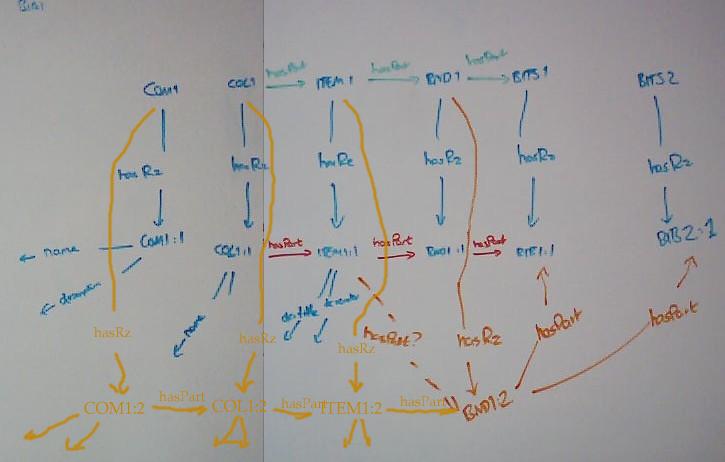- From: Kevin Smathers <kevin.smathers@hp.com>
- Date: Thu, 22 May 2003 15:28:26 -0400 (EDT)
- To: "Tansley, Robert" <robert.tansley@hp.com>
- Cc: "(www-rdf-dspace@w3.org)" <www-rdf-dspace@w3.org>
- Message-ID: <3ECD25D6.20007@hp.com>
Tansley, Robert wrote:
>>Tansley, Robert wrote:
>>
>>
>>
>>>This looks fine, until you actually try and change something. Say I
>>>add a new bitstream, BITS2, to BND1. I've shown this in that nasty
>>>orange colour. This obviously consistutes a change in BND1;
>>>
>>>
>>you can't
>>
>>
>>>just draw another hasPart arc between BND1:1 and BITS2:1, since you
>>>would never be able to tell that BND1 in one situation
>>>
>>>
>>contained only
>>
>>
>>>BITS1. So, you create a new situation for BND1, called BND1:2, and
>>>have hasPart arcs between that and BITS1:1 and BITS2:1.
>>>
>>>
>>(This assumes
>>
>>
>>>that the situation of BITS1 is not changed by virtue of the
>>>
>>>
>>fact that
>>
>>
>>>the Bundle it is in has changed.)
>>>
>>>
>>>
>>This is only a problem for content based identifiers (see my rambling
>>answer to Mark). When using resource identifiers the two
>>instances of
>>BND1:1 are distinct, so there is no confusion between the two chains.
>>
>>Collapsing all nodes that have the same contents by using
>>content based
>>identifiers is an invalid optimization, as this use case shows (among
>>others.)
>>
>>
>
>
>Hi Kevin,
>
>I'm afraid I really don't understand what you've said here. Which response to Mark are you talking about? BND1:1 is a single node in the graph. So you might have in two separate parts of the History data,
>
>BND1:1 -- hasPart --> BITS1:1
>
>BND1:1 -- hasPart --> BITS2:1
>
>By definition, aren't the two BND1:1's the same node? Do I have some serious misunderstanding about the basics of RDF here?
>
> Robert Tansley / Hewlett-Packard Laboratories / (+1) 617 551 7624
>
>
The question is why you decided to use BND1:1 rather than BND1:2. If
the choice of BND1:1 was required because the resource at that node is
identified by a content based identifier, then information has been lost
about the distinct nature of the two instances. The graph looks wrong;
the second chain is logically independent of the first, yet you've
combined the nodes early in the chain, dividing them only where the
content has changed. I think you instead should consider the instance
chain to be independent of the content (see attachment.)
--
========================================================
Kevin Smathers kevin.smathers@hp.com
Hewlett-Packard kevin@ank.com
Palo Alto Research Lab
1501 Page Mill Rd. 650-857-4477 work
M/S 1135 650-852-8186 fax
Palo Alto, CA 94304 510-247-1031 home
========================================================
use "Standard::Disclaimer";
carp("This message was printed on 100% recycled bits.");
Attachments
- image/jpeg attachment: history-graph.jpg

Received on Friday, 23 May 2003 03:17:20 UTC